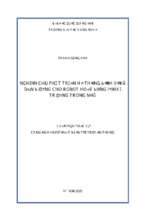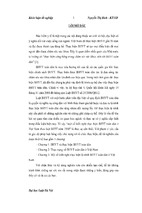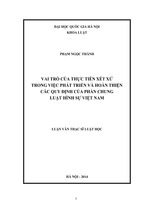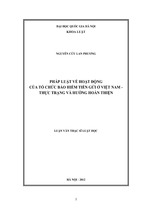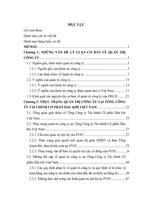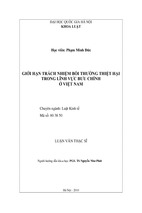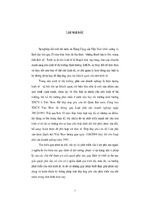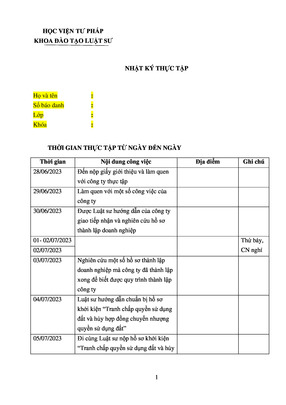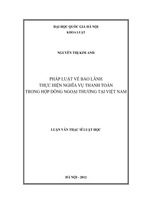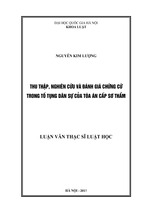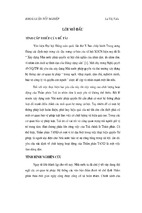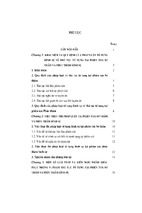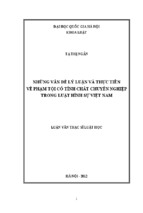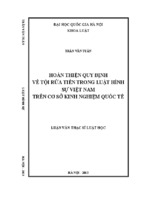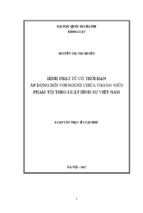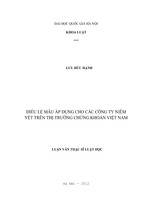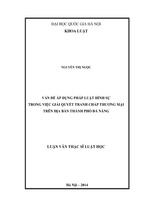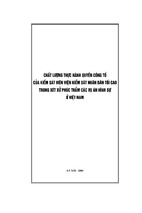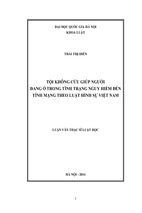HO CHI MINH CITY UNIVERSITY OF LAW
FACULTY OF INTERNATIONAL LAW
-----------***-----------
NGUYỄN HOÀNG NHI
STUDENT ID: 1853801011291
BALANCING FAIR AND EQUITABLE
TREATMENT STANDARD AND
ENVIRONMENTAL PROTECTION IN
INTERNATIONAL INVESTMENT LAW
BACHELOR THESIS
School year: 2018 - 2022
Supervisor:
LL.M Nguyen Thi Lan Huong
Ho Chi Minh City – Year 2022
HO CHI MINH CITY UNIVERSITY OF LAW
FACULTY OF INTERNATIONAL LAW
-----------***-----------
NGUYỄN HOÀNG NHI
STUDENT ID: 1853801011291
BALANCING FAIR AND EQUITABLE
TREATMENT STANDARD AND
ENVIRONMENTAL PROTECTION IN
INTERNATIONAL INVESTMENT LAW
BACHELOR THESIS
School year: 2018 - 2022
Supervisor:
LL.M Nguyen Thi Lan Huong
Ho Chi Minh City – Year 2022
DECLARATION
I declare that this thesis is the result of my research, which is implemented under
the supervision of LL.M Nguyen Thi Lan Huong, ensures honesty, and complies with
rules and regarding quotation, the note of references. Therefore, I hereby take full
responsibility for this declaration.
LIST OF ABBREVIATIONS
ASEAN
Association of Southeast Asian Nations
BIT
Bilateral Investment Treaty
CIL
Customary International Law
CPTPP
Comprehensive and Progressive Agreement for Trans-Pacific
Partnership (2018)
EVIPA
European Union-Vietnam Investment Protection Agreement
2019
FDI
Foreign Direct Investment
FET
Fair and Equitable Treatment
FTA
Free Trade Agreement
FTC Notes
Notes of Interpretation of Certain Chapter 11 Provisions of
North American Free Trade Agreement, issued by the Free
Trade Commission on 31 July 2001
GATT
General Agreement on Tariffs and Trade (1994)
ICSID
International Center for Settlement of Investment Disputes
IIA
International Investment Agreement
IIL
International Investment Law
MST
Minimum Standard of Treatment
NAFTA
North American Free Trade Agreement (1993)
OECD
Organization for Economic Cooperation and Development
RCEP
Regional Comprehensive Economic Partnership (2020)
VCLT
Vienna Convention on the Law of Treaties (1969)
WTO
World Trade Organization
TABLE OF CONTENTS
INTRODUCTION ......................................................................................................... 1
CHAPTER 1. OVERVIEW ON FAIR AND EQUITABLE TREATMENT
STANDARD AND ENVIRONMENTAL PROTECTION IN INTERNATIONAL
INVESTMENT LAW .................................................................................................. 10
1.1 Theoretical issues with regard to fair and equitable treatment standard .... 10
1.1.1 Historical origin and meaning of fair and equitable treatment standard ....... 10
1.1.2 Formulations and interpretation of fair and equitable treatment standard in
international investment treaties ............................................................................. 14
1.2 Environmental protection right of states ......................................................... 19
1.2.1 Legal basis of environmental protection right of states - right to regulate in
the public interest ................................................................................................... 19
1.2.2 Regulations on environmental protection in international investment
treaties..................................................................................................................... 24
1.3. Conflicts between the obligation to accord fair and equitable treatment
standard under international investment agreements and the exercise of the
environmental protection right of the host state ................................................... 33
CONCLUSION OF CHAPTER 1 .............................................................................. 36
CHAPTER 2. FAIR AND EQUITABLE TREATMENT STANDARD AND
ENVIRONMENTAL PROTECTION IN INTERNATIONAL INVESTMENT
ARBITRATION AND RECOMMENDATIONS FOR VIETNAM ....................... 37
2.1. Fair and equitable treatment standard standard and environmental
protection in international investment arbitration ............................................... 37
2.1.1 Different approaches taken by arbitral tribunals in environment-related
cases ........................................................................................................................ 37
2.1.2 Towards a balanced approach between fair and equitable treatment standard
and environmental protection's right of the host state ............................................ 55
2.2 Recommendations for Vietnam ........................................................................ 66
2.2.1 Recommendations regarding investment treaty drafting ............................... 71
2.2.2 Recommendations regarding environmental policies and measures ............. 73
CONCLUSION OF CHAPTER 2 .............................................................................. 76
THESIS CONCLUSION ............................................................................................. 77
INTRODUCTION
1. Problem statement
In this day and age, the enhancement of environmental protection standards, the
progress made in the governance of sustainable development, together with the
occurrence of many environmental incidents relating to investment activities have
motivated governments to review, amend and update their domestic legal policies so as
to keep them in line with social development requirements. In such a context, states can
be placed in a dilemma since at the same time, they have to comply with obligations to
protect foreign investment regulated in international investment agreements (“IIAs”).
Arbitral practice indicates that there are many disputes between the host states and
foreign investors arising out of the country’s failure to maintain a favorable legal
framework for investment when pursuing their non-commercial objectives.1
The harmony between the state’s objective to attract foreign direct investment
(“FDI”) by affording investment protection and the protection of the environment has
long been a matter of considerable concerns in international investment law (“IIL”),
mainly in IIAs and in the process of resolving investor-state disputes. To tackle this
matter, states begin to review the content of their IIAs in an attempt to ensure both
commitments regarding investment protection and sufficient policy space to exercise
their sovereign rights concerning environmental issues. Typical of such an attitude is the
amendment of IIAs’ preamble, the incorporation of general and specific exceptions as
well as new methods of regulation on standards of investment protection such as most
favored nation standard, fair and equitable treatment (“FET”) standard and expropriation
clauses.2 Among them, the FET standard is controversial among scholars and has
1
Saverio Di Benedetto, International Investment Law and The Environment, Elgar International Investment Law,
2013, p. 4.
2
Nguyen Thi Lan Huong, “Liên hệ tiêu chuẩn “đối xử công bằng và thỏa đáng” với mục tiêu bảo vệ môi trường
trong CPTPP – Một số đề xuất cho Việt Nam” (The relationship between “Fair and Equitable” and environmental
purpose in CPTPP – Recommendations for Vietnam), Vietnamese Journal of Legal Science, 2019, Volume 06, p.
82-94.
1
become the most common standard for the resolution of investment disputes in recent
years, particularly those involving tensions between an investor’s rights and the state’s
regulatory measures.3 This stems from the vague, general and inconsistent regulation of
FET provisions in IIAs as well as the broad interpretation of such a standard.4 Following
this is the possibilities of different interpretation of the FET standard in arbitral
jurisprudence, thus restricting the predictability of the outcome of investor-state
disputes. A more serious consequence is that states may refrain from adopting legitimate
environmental regulations for fear of being challenged (or threatened to challenge) by
foreign investors before arbitral tribunals when investors feel that it is difficult to carry
on their business in the host state or that value of their investments has diminished as a
result of certain environmental regulations.5
With this situation in mind, the balance between the FET accorded to foreign
investors regulated in IIAs and the regulatory power of states to pursue their
environmental objectives is an urgent concern. Thus, this thesis with the topic
“Balancing fair and equitable treatment standard and environmental protection in
international investment law” aims to analyze the FET standard, the environmental
protection rights of states and their relevance in arbitral jurisprudence, thereby providing
recommendations for Vietnam.
2. Literature review
Many studies on the FET standard and its relations with the environment have been
recorded internationally, mostly as part of the comprehensive research on IIL and
sustainable development. In Vietnam, however, FET standard and environmental
protection have not been profoundly researched. Existing literature relevant to this issue
3
Suzanne A. Spears, “The quest for policy space in a new generation of international investment agreements”,
Journal of International Economic Law, 2010, Vol. 13 No. 4, p. 1052.
4
Ying Zhu, “Fair and Equitable Treatment of Foreign Investors in an Era of Sustainable Development”, Natural
Resources Journal, 2018, Volume 58, p. 325.
5
Satwik Shekhar, ‘Regulatory chill’: Taking right to regulate for a spin, Centre for WTO Studies, 2016, p. 5-6.
2
is limited, and where it is available, it pays attention to newly-concluded treaties entered
into by Vietnam such as the Comprehensive and Progressive Agreement for TransPacific Partnership 2018 (“CPTPP”).
2.1 Materials in Vietnamese
●
Books/ Textbooks
Trinh Hai Yen, Textbook on International Investment Law, The Truth National
Political Publishing House, Ha Noi, 2017: The textbook provides general knowledge of
international investment law. The author analyzes the FET standard and its application
in practice in chapter V of the textbook. The analysis on environmental protection is
merely generally provided in section II Chapter VII of the textbook and its interaction
with the FET standard has yet to be mentioned.
●
Scientific articles/ scientific research
Tran Thang Long, “Áp dụng quy định trường hợp ngoại lệ về môi trường trong
pháp luật đầu tư quốc tế và một số so sánh với thực tiễn Việt Nam” (Application of
Provision on Environmental Exception in International Investment Law and
Comparisons with Vietnamese Practices), Legislative Studies Journal, 2019, No 4/2019:
The article analyzes environmental exception provisions in IIAs and how they are
applied in investment cases. Thereby, the author compares them with the situation of
Vietnam and offers some recommendations for Vietnam. Although the article provides
details about environmental protection, the focus of the study is on expropriation instead
of the FET standard.
Nguyen Thi Lan Huong, “Liên hệ tiêu chuẩn “đối xử công bằng và thỏa đáng” với
mục tiêu bảo vệ môi trường trong CPTPP – Một số đề xuất cho Việt Nam” (The
relationship between “Fair and Equitable” and environmental purpose in CPTPP –
Recommendations for Vietnam), Vietnamese Journal of Legal Science, 2019, Volume
06: The author analyzes how the FET standard is variably regulated under international
investment treaties and the way it affects the FET interpretation in investment arbitral
3
tribunal in practice. Thereby, the author gives an insight into the relationship between
FET standard and environmental protection objectives in CPTPP and offers some
recommendations for Vietnam so as to effectively implement environmental protection
policies without violating the FET standard in IIAs where Vietnam is a member.
However, since the scope of the article is limited to provisions under CPTPP, the author
exclusively focuses on the FET standard that is linked to the customary international law
(“CIL”), which cannot provide a general picture of the link between the FET standard
and environmental objectives.
Nguyen Xuan My Hien, “Sự phát triển của tiêu chuẩn đối xử công bằng và thỏa
đáng trong hiệp định thương mại tự do thế hệ mới” (The development of the FET
standard in new generation free trade agreements), Vietnamese Journal of Legal Science,
2019, Volume 06: The article analyzes the definition, characteristics, purpose of the FET
standard and compares how the FET standard is regulated in traditional IIAs and new
generation IIAs, in order to see the attempt of states to address the conflict between the
requirement of foreign investor protection and the host state’s sustainable development
objective. Yet, since the article does not specifically address the environmental objective
of the host state and the focus is on the provisions of the FET standard under the CPTPP,
further research on the FET and environmental protection is in need.
●
Theses
Ngo Nguyen Thao Vy, “Quy định về quyền bảo vệ môi trường của nhà nước tiếp
nhận đầu tư trong khuôn khổ các hiệp định đầu tư quốc tế - Kiến nghị cho Việt Nam”
(Regulations on environmental protection rights of the host state in international
investment treaties - Recommendations for Vietnam), Master thesis, Ho Chi Minh City
University of Law, 2018: The thesis analyzes states’ right to protect public interest in
general and states’ right to protect the environment in particular through provisions under
IIAs and practical case study. The thesis also demonstrates recent trends in interpreting
the right to protect the public interest of the host state. Thereby, some recommendations
4
for Vietnam are given. However, the thesis does not provide in-depth research on
environmental protection right in relation to the FET standard.
Nguyen Ngoc Mai Thy, “Vấn đề bảo vệ lợi ích công cộng khi giải quyết tranh chấp
giữa quốc gia và nhà đầu tư nước ngoài trong hiệp định đầu tư quốc tế - Kinh nghiệm
cho Việt Nam” (The protection of public interest when resolving disputes between the
host states and foreign investors - Recommendations for Vietnam), Master thesis, Ho
Chi Minh City University of Law, 2017: In this thesis, a general overview of public
interest in international investment law and in international investment arbitration, as
well as an assessment of the approach in dealing with public interest matters of the
arbitral tribunals through their decisions are provided. Thereby, the author analyzes the
approach of Vietnam with regard to public interest protection and offers some
recommendations. However, environmental protection, as an aspect of public interest
protection, and its link to the FET standard have not yet been deeply researched.
2.2 Materials in foreign language
●
Books/ Curricula
Saverio Di Benedetto, International Investment Law and The Environment, Elgar
International Investment Law, 2013: The book clarifies the conflicting relationship
between international investment rules and environmental protection. It further provides
a critical analysis of case-law arguments and treaty solutions that address the integration
of environmental concerns into IIL. Thereby, the book outlines possible scenarios for
the evolution of the integrative question. More research is needed to elaborate on, in
particular, the FET standard and its interaction with environmental protection.
●
Scientific articles/ scientific research
Ying Zhu, Fair and Equitable Treatment of Foreign Investors in an Era of
Sustainable Development, Natural Resources Journal, 2018, Volume 58: The article
analyzes models adopted by tribunals in crafting the general threshold of the FET
standard in environment-related investment cases and examines the tribunals’ diverse
5
approaches to assessing the FET in such cases. Thereby, the article offers
recommendations towards an integrated methodology for assessing environmental
regulations under the FET. Since the article focuses on the analysis in arbitral practice,
the theoretical issues have yet to be thoroughly discussed.
Federico Ortino, The Obligation of Regulatory Stability in the Fair and Equitable
Treatment Standard: How Far Have We Come?, Journal of International Economic Law,
2018, 21, p. 845-865: The article elaborates on the conceptual distinction between 'strict'
and 'soft' stability obligations of the host states. Through the analysis of the way
investment treaty tribunals have applied the FET provision in cases of host states'
regulatory change, the author’s main argument is that several recent arbitral tribunals
still fail to clearly set out the role of regulatory stability within the FET standard. The
article focuses on regulatory stability as one element of the FET standard and therefore,
the FET standard in general has not been comprehensively researched.
Camille Martini, Balancing Investors' Rights with Environmental Protection in
International Investment Arbitration: An Assessment of Recent Trends in Investment
Treaty Drafting, International Lawyer, 2017, Volume 50, No 3, p. 529 - 583: The article
assesses the differences in the way recent arbitral tribunals have interpreted IIAs'
provisions to solve the conflict between investors' rights and states' ability to regulate on
environmental matters. Then, the environmental protection provisions that states have
incorporated in newly drafted IIAs are analyzed, which demonsrates the states’ attempt
to incorporate public concerns directly into the text of their investment agreements.
However, the study has not yet been deeply researched on the FET standard as a whole
but rather focuses on legitimate expectations amongst the several components of the FET
standard.
Tarcisio Gazzini, Bilateral Investment Treaties and Sustainable Development, The
Journal of World Investment & Trade, 2014, No 15, p. 929 - 963: In this article, the
author explores the relationship between foreign investment and sustainable
6
development. Through examining recent treaty practice, the author assesses how States
can take full advantage of investment treaties as vehicles for economic development
without compromising on the protection of the environment. Thus, the article provides a
general picture instead of in-depth research on the FET standard and its relation to
environmental protection.
●
Theses
Le Thi Ngoc Ha, Vietnam’s International Investment Agreements: Various
Substantive Compatibility Thresholds For Legislative Measures, La Trobe University,
Australia, 2021: The author provides an extensive research of the context of investment
protection provisions governing substantive aspects of legislative measures in Vietnam’s
IIAs. Thereby, the author clarifies substantive requirements and/or qualifications for
legislative measures and substantive qualifications for exceptional legislative measures
possibly imposed by provisions in Vietnam’s IIAs (including those for FET standard and
those for public interests). As the author limits her research objectives to Vietnam’s IIAs,
further research on international investment treaties and their links to Vietnamese
context is necessary.
Dávid Rédli, Limitations to States’ Regulatory Power in International Investment
Arbitration Resulting from Standards of Protection, with a Focus on Fair and Equitable
Treatment Standard, Masasryk University, 2016: The thesis provides analysis on
sovereignty of states, the FET standard, as well as how to balance private and public
interest in IIL by using the proportionality test. The thesis also demonstrates the
confining approach and benevolent approach of arbitral tribunal towards states’ right to
regulate. However, the matter of environmental protection has yet to be fully discussed
in this thesis.
3. Purpose of the study
This thesis aims to analyze the relationship between the FET standard and
environmental protection in IIL by assessing IIAs’ languages and the evaluation of
7
international investment arbitration, thereby providing recommendations for improving
and balancing the investor protection obligation and the environmental protection right
of states, especially in the context of Vietnam.
To accomplish the above purpose, this thesis performs the following tasks:
First, analyze such theoretical issues of the FET standard as its origin, its meaning,
and how it is regulated and interpreted under IIAs. Additionally, analyze the basis for
the environmental protection right of states and how it is regulated under IIAs.
Second, analyze two selected cases to clarify different approaches adopted by
arbitral tribunals in environmental-related cases.
Third, offer problem-solving recommendations for a better balance between the
FET standard and environmental protection and link to the current situation in Vietnam.
4. Objectives and scope of the study
4.1 Objectives of the study
The regulations and provisions relating to the FET standard and environmental
protection in international investment treaties and in investment treaties of which
Vietnam is a member, especially those recently concluded including the CPTPP, the
Regional Comprehensive Economic Partnership 2020 (“RCEP”) and the European
Union-Vietnam Investment Protection Agreement 2019 (“EVIPA”).
Tribunal approaches towards FET in environmental-related cases resolved by
international investment tribunals.
4.2 Scope of the study
As to the content, this thesis studies mainly on the basic theoretical issues and
practical matters arising from the relationship between the FET standard and
environmental protection.
As to the space, this thesis analyzes decisions of arbitral tribunals in international
investment disputes relating to the FET and environmental protection. Additionally,
8
relevant IIAs’ provisions are under discussion to clarify how states govern this matter in
reality.
As to the time, this thesis focuses on recent discussions and case studies from 2010
onward.
5. Research methodologies
Throughout the thesis, the author will utilize three main research methods:
analytical, comparative, and synthetic. These research methods are determined not to be
set to isolation but in interweavement.
The analytical method is conducted in both chapters. In chapter 1, this method is
used to analyze the basis theoretical issues with regard to both FET standard and
environmental protection in IIL. In chapter 2 this method is applied in order to point out
the problems of the divergent ways taken by arbitral tribunals in cases related to
environmental issues.
The comparative method is implemented in Chapter 2 for comparing the two
different approaches taken by arbitral tribunals to resolve disputes arising from the
conflict between investor protection and environmental protection.
The synthetic method is used to synthesize analyses and comparisons, thereby
providing a general picture of the situation and offering recommendations.
6. Thesis structure
This thesis is structured in two chapters as follows:
Chapter 1. Overview on FET standard and environmental protection in
international investment law
Chapter 2. FET standard and environmental protection in international investment
arbitration and recommendations for Vietnam
9
CHAPTER 1. OVERVIEW ON FAIR AND EQUITABLE TREATMENT
STANDARD AND ENVIRONMENTAL PROTECTION IN INTERNATIONAL
INVESTMENT LAW
This Chapter will introduce the FET standard with regard to its historical origin,
meaning, as well as how the standard is formulated under international investment
treaties and variously interpreted. This Chapter will also analyze the environmental
protection right of states in respect of the legal basis for states to exercise their right to
protect the environment and how matters of the environment is regulated under IIAs.
Accordingly, conflicts between the obligation to follow the FET standard under IIAs and
the exercise of the environmental protection right of the host state will subsequently be
demonstrated.
1.1 Theoretical issues with regard to fair and equitable treatment standard
1.1.1 Historical origin and meaning of fair and equitable treatment standard
The obligation to provide “fair and equitable treatment” is often stated, together
with other standards, as part of the protection due to foreign direct investment by host
countries. It is an “absolute”, “non-contingent” standard of treatment whose exact
meaning has to be determined, by reference to specific circumstances of each case, as
opposed to the “relative” standards embodied in “national treatment” and “most favored
nation” principles, which have recourse to the treatment accorded to other investment to
define the required treatment.6
As to its historical origin, the concept of FET is not new but has appeared in
international documents for some time. An early version of the FET standard appeared
in Article 11(2) of the Havana Charter for the establishment of an International Trade
6
OECD, “Fair and Equitable Treatment Standard in International Investment Law”, OECD Working Papers on
International Investment, 2004, 2004/03, p. 2
10
Organization in 1948, assuring “just and equitable treatment for the enterprise, skills,
capital, arts and technology brought from one Member country to another.”7
Although the Havana Charter failed to enter into force, this early model of the FET
standard was subsequently incorporated into certain United States Friendship,
Commerce and Navigation Treaties (FCN Treaties), with a reference either to
“equitable” treatment or to “fair and equitable” treatment.8 The first use of the FET
clause in the IIA context can be traced back to Article I of the Draft Convention on
Investments Abroad proposed by Hermann Abs and Lord Shawcross in 1959: “Each
Party shall at all times ensure fair and equitable treatment to the property of the
nationals of the other Parties…”. Following this, the 1967 Organization for Economic
Cooperation and Development (“OECD”) Draft Convention on the Protection of
Foreign Property also included a FET clause along similar lines.9 It is important to note
here that the Draft OECD Convention was used by most OECD countries as the basis
for their IIA negotiations. By referring to the OECD model and using it systematically,
they are also referring to this standard as defined by the Draft Convention of 1967.
Nowadays, almost all modern bilateral investment treaties (“BITs”) and multilateral
IIAs include FET clauses.10 Even some Asian and Latin American countries that
traditionally favored the use of national treatment rather than the FET standard for a
better control of foreign investments, have incorporated FET clauses into their BITs.11
As to its meaning, although most investment protection agreements require that
investments and investors covered receive “fair and equitable” treatment, there is no
7
Havana Charter for an International Trade Organization, U.N. Doc. E/Conf. 2178, art. 11(2)(a)(i) (Mar. 24, 1948).
For example, Article I(1) of the 1954 United States-Germany FCN Treaty reads: “Each Party shall at all times
accord fair and equitable treatment to the nationals and companies of the other Party and to their property,
enterprises and other interests.”
9
Article 1(a) of the 1967 OECD Draft Convention on the Protection of Foreign Property provides: “Each Party
shall at all times ensure fair and equitable treatment to the property of the nationals of the other Parties.”
10
August Reinisch and Christoph Schreuer, International Protection of Investments: The Substantive Standards,
Cambridge University Press, 2020, p. 259.
11
Ying Zhu, supra note 4, p. 323.
8
11
general agreement on the precise meaning of this standard. According to the Concise
Oxford Dictionary, the word “fair” is defined as “just, unbiased, equitable, in accordance
with rules”.12 Meanwhile, “Equity” is a word related to the idea of equilibrium defined
as “a state of physical balance”.13 A noticeable question that has been raised is whether
the FET standard actually contains two independent standards, namely “fair” and
“equitable”. In practice, it is generally assumed that “fair and equitable” must be
considered to represent “a single, unified standard”.14 What is more, in many agreements
– especially in Spanish and French language treaties – the phrase appears as “just and
equitable treatment” instead of “fair and equitable treatment”.15 A few BITs also refer to
‘equitable and reasonable’ treatment.16 However, these variations have been generally
viewed as insignificant and can be used interchangeably with the term “fair and
equitable”.17 Based on a plain meaning of the words, “fair and equitable” treatment
requires “an attitude to governance based on an unbiased set of rules that should be
applied with a view to doing justice to all interested parties that may be affected by a
State’s decision in question, including the host State’s population at large”.18
Many of the substantive investment protection standards seem to have been
intentionally drafted in vague terms in order to conceal differing perceptions on the value
12
The Concise Oxford Dictionary of Current English, Eighth edition, Clarendon Press, Oxford University Press,
1990, p. 420.
13
The Concise Oxford Dictionary of Current English, Eighth edition, Clarendon Press, Oxford University Press,
1990, p. 396
14
Rudolf Dolzer and Christoph Schreuer, Principles of International Investment Law, Oxford University Press,
2012, p. 123; August Reinisch and Christoph Schreuer, supra note 10, p. 276.
15
For example, Article IV.1 Spain–Mexico BIT (2006): “Cada parte contratante otorgará a las inversiones de
inversores de la otra parte contratante, trato acorde con el derecho internacional consuetudinario, incluido trato
justo y equitativo, así como protección y seguridad plenas”.
16
For example, Article III Norway–Lithuania BIT (1992) provides that each contracting party shall promote and
encourage in its territory investments of investors of the other contracting party and accept such investments in
accordance with its laws and regulations and accord them equitable and reasonable treatment and protection.
17
August Reinisch and Christoph Schreuer, supra note 10, p. 261; UNCTAD, Fair and equitable treatment - A
sequel, Series on Issues in International Investment Agreements II, 2012, p. 20.
18
UNCTAD, supra note 17, p. 7.
12
of investment protection.19 Similarly, the term “fair and equitable treatment” appears as
a vaguely and generally formulated standard. However, it is arguable that the FET
standard has an inherent nature of vagueness and generality on purpose. It derives from
the FET standard's very function, which is to address acts and occurrences that do not
come under the purview of particular standards but are nevertheless considered to be at
odds with the BIT's goal of protecting and promoting foreign investment.20
A considerable number of arbitral awards have gone a long way towards
identifying the precise meaning of this rather vague and generally formulated standard
through judicial practice. A tribunal may limit its attention to one FET standard criterion
that applies to the case in order to accomplish this. A rising number of tribunals,
however, have taken on the more extensive duty of presenting a list of elements that,
taken together, may constitute the full scope of the FET standard.21 For the first time, the
“list approach” was employed in Tecmed v. Mexico22. The Tribunal in this case held that
the FET requires the host state to protect “basic expectations” that were taken into
account by the foreign investor to make the investment; to act in a “consistent”, “free
from ambiguity”, “totally transparent” manner so that the foreign investor may know
beforehand any and all rules and regulations that will govern its investments, as well as
the goals of the relevant policies and administrative practices or directives, to be able to
plan its investment and comply with such regulations. Further, the FET, according to the
Tribunal, requires the host state to act in a way without arbitrarily revoking any
preexisting decisions or permits issued by the State that were relied upon by the investor
to assume its commitments as well as to plan and launch its commercial and business
19
Roland Klager, ‘Fair and Equitable Treatment’ in International Investment Law, Cambridge University Press,
2011, p. 4.
20
Rudolf Dolzer, “Fair and Equitable Treatment: Today’s Contours”, Santa Clara Journal of International Law,
2013, Volume 12, p. 12.
21
Rudolf Dolzer, “Fair and Equitable Treatment: Today’s Contours”, Santa Clara Journal of International Law,
2013, Volume 12, p. 14.
22
Tecnicas Medioambientales Tecmed S.A. v. United Mexican States, ICSID Case No. ARB(AF)/00/2, Award, 29
May 2003, para. 154.
13
activities, and use the legal instruments that govern the actions of the investor or the
investment in conformity with the function usually assigned to such instruments, and not
to deprive the investor of its investment without the required compensation. It bears
emphasis that the Tecmed Award has been and continues to be the award that arbitral
jurisprudence cites the most, clearly having more weight than other attempts to approach
the standard.23
1.1.2 Formulations and interpretation of fair and equitable treatment
standard in international investment treaties
It is noticeable that there has been no uniform formulation of the FET clause among
investment treaties.24 In fact, the language of the FET clause differs significantly among
treaties. Some treaties simply require “fair and equitable treatment” without any
reference to international law or any further criteria. FET clauses of this type are referred
to as unqualified, autonomous or self-standing FET standard. An example can be seen
in Article 3 of Belgium - Luxembourg Economic Union-Tajikistan BIT (2009): “All
investments made by investors of one Contracting Party shall enjoy a fair and equitable
treatment in the territory of the other Contracting Party”. Some treaties link the FET
standard to general international law. For instance, Article 3(2) of Croatia-Oman BIT
(2004) provides: “Investments or returns of investors of either Contracting Party in the
territory of the other Contracting Party shall be accorded fair and equitable treatment
in accordance with international law and provisions of this Agreement”. Some treaties
equate the FET standard to the minimum standard of treatment (“MST”) in CIL. MST
is a set of CIL norms that governs the treatment of aliens.25 Accordingly, the MST asserts
a level of protection for aliens, below which the treatment provided for by the host state
23
Rudolf Dolzer, “Fair and Equitable Treatment: Today’s Contours”, Santa Clara Journal of International Law,
2013, Volume 12, p. 14.
24
OECD, “Fair and Equitable Treatment Standard in International Investment Law”, OECD Working Papers on
International Investment, 2004, 2004/03, p. 40.
25
UNCTAD, supra note 17, p. 44.
14
- Xem thêm -


